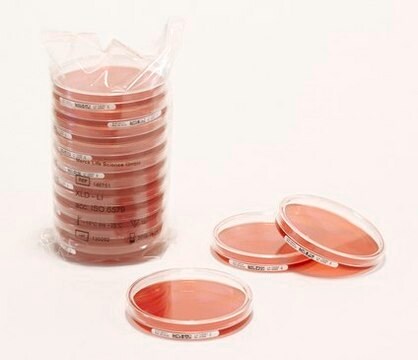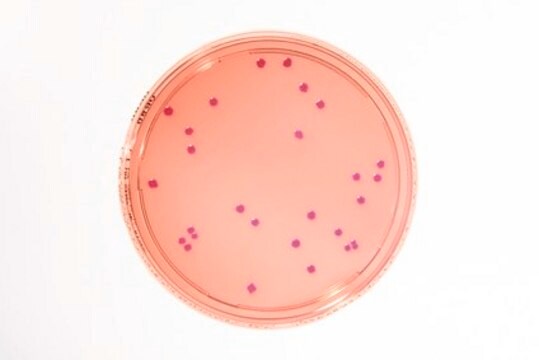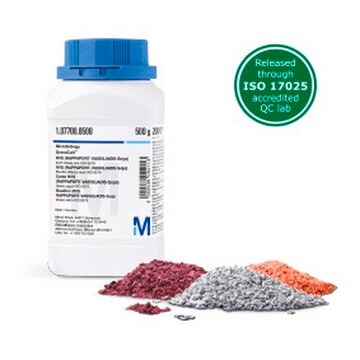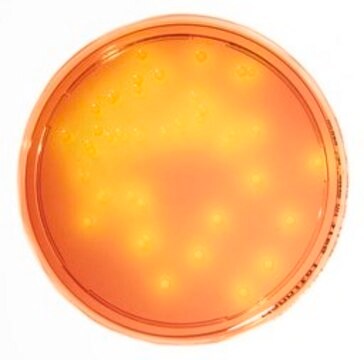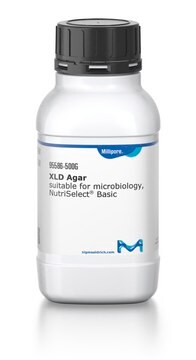1.46073
HEIMPLATE XLD Agar - LI EP+USP 30ml
Selective media for the isolation of Salmonella and Shigella in pharmaceuticals and clinical materials
Synonim(y):
Xylose Lysine Deoxycholate Agar
Zaloguj sięWyświetlanie cen organizacyjnych i kontraktowych
About This Item
Kod UNSPSC:
41106217
NACRES:
NA.74
Polecane produkty
agency
EP 2.6.12
USP 61
Poziom jakości
sterylność
sterile
Postać
solid
Właściwości
ready-to-use
metody
microbiological culture: suitable
pH
7.4 ( in H2O)
Zastosowanie
microbiology
pharmaceutical
temp. przechowywania
20-25°C
przydatność
Salmonella spp. (spp.)
Opis ogólny
Xylose Lysine Deoxycholate agar (XLD agar) is a selective growth medium introduced by Taylor (1965) for the isolation of Salmonella and Shigella species (Taylor and schelbert, 1971). It relies on the use of selective inhibitory component sodium deoxycholate and three indicator systems, i.e. xylose, lactose and sucrose combined with phenol red. Degradation of xylose, lactose, and sucrose to acid causes phenol red to change its colour to yellow. Sodium thiosulfate and iron (III) salt react to form a precipitate of black iron sulfide in the colonies, indicating the production of hydrogen sulfide. Bacteria which decarboxylate lysine to cadaverine can be recognized by the appearance of a purple coloration around the colonies due to an increase in pH. These reactions can proceed simultaneously or successively. This causes the pH indicator to exhibit various shades of colour, or it may change its colour from yellow to red on prolonged incubation. The culture medium is weakly inhibitory to other microbes due to the presence of sodium deoxycholate.
Zastosowanie
Xylose Lysine Deoxycholate (XLD) Agar - LI is a selective culture medium for isolation of Salmonella and Shigella in pharmaceuticals.
Opakowanie
90 mm settle plates with 30 ml filling volume (20 or 120 plates per box) for long incubation (LI)
This page may contain text that has been machine translated.
Kod klasy składowania
13 - Non Combustible Solids
Klasa zagrożenia wodnego (WGK)
WGK 2
Certyfikaty analizy (CoA)
Poszukaj Certyfikaty analizy (CoA), wpisując numer partii/serii produktów. Numery serii i partii można znaleźć na etykiecie produktu po słowach „seria” lub „partia”.
Masz już ten produkt?
Dokumenty związane z niedawno zakupionymi produktami zostały zamieszczone w Bibliotece dokumentów.
Handbook of culture media for food and water microbiology
Curtis, GDW and Baird, Rosamund M and Corry, Janet EL et al.
Royal Society of Chemistry (2011)
Nasz zespół naukowców ma doświadczenie we wszystkich obszarach badań, w tym w naukach przyrodniczych, materiałoznawstwie, syntezie chemicznej, chromatografii, analityce i wielu innych dziedzinach.
Skontaktuj się z zespołem ds. pomocy technicznej
